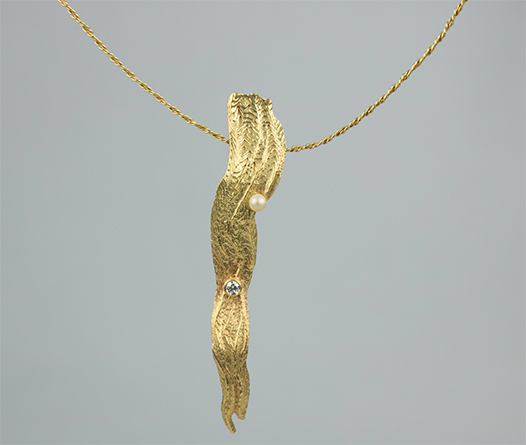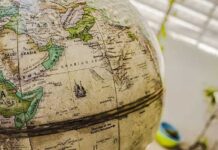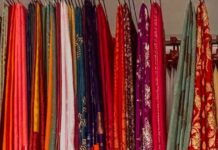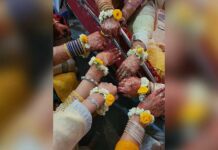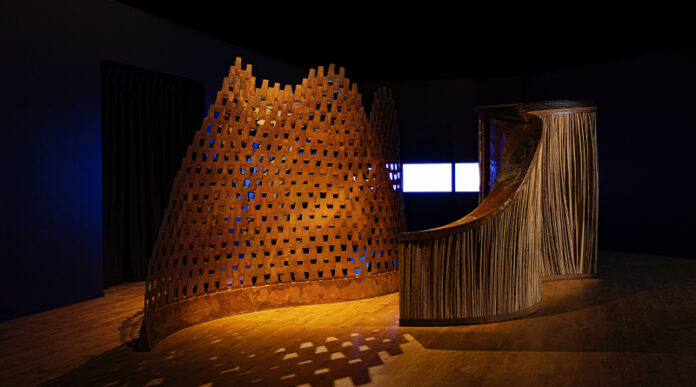
By Shaikha Alshamsi
Azza Alqubaisi is known as a jewelry artist, product designer and sculptor. She is commonly referred to as the first Emirati jewelry maker in the United Arab Emirates. Alqubaisi finds joy in experimenting with raw materials that are a part of the UAE heritage to express her cultural identity. All her works include different materials that were considered an important part of the lives of Emirati families specifically during the pre-oil period. Her artworks also combine references to the natural world with cultural allusions, including the desert patterns, shapes and textures as well as the resurgence of traditional ancient techniques. Alqubaisi was born in Abu Dhabi and educated in London. She holds a master’s degree in cultural and creative industries from HCT-CERT and bachelor’s degree in silversmithing, allied crafts and jewelry design from London Guildhall. The artist was able to exhibit her work nationally and internationally. She represented the UAE in “A 1001 steps festival” in Helsinki, Finland, in 2004. Alqubaisi was also the first to exhibit her artworks at the Dubai International Financial Centre in 2005. Her creations have traveled the world, ambassadors to Emirati art in various competitions and events.
Who is Azza Alqubaisi? Specifically, how do you define yourself?
It varies to whom and when I’m answering this. Azza Alqubaisi is an Emirati artist who creates wearable art and sculptures. I have been designing and introducing Emirati designs for the past 15 years.
Since you are the first Emirati jewelry designer, can you tell us about what made you choose jewelry as art?
As a first national jewelry designer and maker and as an artist, I wanted to be able to express myself in a medium and in a material that can reflect my personality. My selection of jewelry and not sculpture specifically goes back to the idea that I wanted the engagement of the body. I wanted my pieces to connect as a way of expression but also a connection between art and design because traditionally, jewelry has been mainly used as a design or as a value of gold to obtain and buy. So, I felt that as a medium, I would be able to reach more audiences and share my vision and my love of nature and the environment to reflect it through a medium that connects with a lot of sectors of society. Saying that, that was my initial vision but because as an artist, we are never confined to a specific field only. That is why I always say that scale is always just a scale so whether we wear the jewelry, or it wears us meaning my large-scale sculpture, it is the engagement between both the human and the art.
Did you face any difficulties while pursuing your career since some people might disagree with defining jewelry as a type of art?
Definitely. I mean wearable art is an existing sector in art. It exists internationally if not all countries of the world. With materials, it’s not just about being precious but also about expressing different views. When I started, it was extremely difficult because it was a new medium. Jewelry is an established design sector and a brand-oriented sector, so if you are not buying Bahraini jewelry or Indian jewelry, you are buying brands. As a sector, it is very much defined and mature to be brand-oriented and not art oriented. Today, after two decades of my experience and struggle, it has evolved and there is so much more respect and appreciation for it. There are also other jewelry artists in the field, maybe not too many, but there are although the stronger sector is design. So, there are more Emirati designers than there are artists, which is fine. I mean for a small population that is acceptable. It is a language that exists; Picasso has jewelry. In fact, at that time, I did not know back then when I selected my field. I did not know there were artists who did jewelry. My selection came out of an inner need for creation and working with metal, and I wanted to be close to the human body. So, that was a desire that I had and a difficulty that I did not realize would be that big or it would take over a decade for people to start understanding me. However, from my first show, I was able to represent my country internationally. I also overcame this difficulty by educating the public through media and all channels available to me and by exhibiting in places such as festivals. I did not confine my art to white boxes or galleries or museums. I see myself as an artist of the public and exhibiting in festivals helped me a lot.
How did this become a part of your ambition to change the prevailing thoughts around jewelry and replace their materialistic value?
I think very early on and going to museums at a young age and seeing how a lot of artists were playing with value, nothing to do with material aspect; one of the exhibits had two pieces with the same price. One was painted so one had gold underneath and the other was plastic. To me, I wanted to remove the connection of value of a material and take the value of it as feeling and thoughts and how I’m translating it into my work. I think the fact that I worked in the beginning with silver, which is a less accepted material as a wearable jewelry, shocked some people. I’m not about the value of material; I am about what I am giving you as a story and what the piece captures just like a painter, but in a different medium and in a different way.
How do you work with jewelry and sculptures without losing your artistic identity?
This has never been an issue for me as an artist; so, over the past few decades, I worked and pushed myself to express myself and I was never frightened by the scale of the work. So, I think maybe what helped me gain more confidence are the opportunities I got, the participation, the grants and the commissions to create specific site location artworks. It was not an easy journey, and it took a lot of time. I think there are more opportunities now than there were when I started. Artists now have the chance to explore their options and move from one medium and scale to another.
As creative ability is what differentiates a real artist, in what way do you think your work differs from other artists’?
My work is me; they are my babies, and they are a reflection of my thoughts and my process. I research in depth; I create and I innovate whether in mediums or materials and I think that’s what makes an authentic artist more than anything and how much they invest in what they are creating. I think with media and YouTube, a lot of people can create art but how much of it is their art is how much research and investment they put in representing themselves. I think my journey revolves around not only materials but also my identity, my representation of my culture and it varies in scale and use. The more invested an artist is in their work, the more it is seen and appreciated by the world. What makes it original is how authentic an artist is, how honest the artist is with the process and method of creation. There is a big difference between design and art. They can cross sometimes, and there is a difference between a person who just draws or designs for a factory to produce the work. There is a big difference between an artist who works by hand, creates, experiments and develops their work. For me, it is the journey, not the destination because today with technology and with 3D printers, anybody can make a sculpture or a jewelry piece. What makes it authentic is the story and the history of that artist.
What inspires your artistic vision?
My vision as an artist is definitely to represent and capture my thoughts that are the main inspiration for my art. What I create is my identity, my environment and the evolution of our traditions.
Once you’ve formed your own ideology, concepts and vision, what made you choose cultural heritage as a way to identify your Emirati identity through your artworks and jewelry?
I think each person seeks to understand an aspect and captures it as an artist by using life and research. For me, I live in a country where the world lives with me, so I find it very interesting to understand what it is to be Emirati, who am I as an Emirati and how we differ amongst ourselves. So, all that together has to be a part of your passion. To me, that ignited me and instilled in me the curiosity to understand that. Through those creations, writing and words, I reach a better understanding of who I am. Another part of it to me is the physical and natural environment. Before becoming an artist, I was very passionate in researching, reading and attending seminars related to climate change. I wanted to create awareness through my work in that regard and how beautiful nature is, and I realized that I love the hot weather after living in London for so many years. I appreciated how our families found their balance. It’s not an easy climate to live in but it also made us the strong people we are today and made us people who can adapt and develop. Within that fast development as well, I feel like we need to keep this balance, and remain connected to the past and our natural environment.
In your work, you narrated the story of pearl diving in the Arabian Gulf using your jewelry collections, how did this come about?
I created a series called “Angel Tears” and with this series, I was able to capture the story of the divers rather than the traders. A lot of what is written shows the trade of pearls and not the ones who were living the hardship. In reality, 90% of those who experienced hardship were the people who had to dive and go through health issues and live a very tough life year by year. I searched and tried to understand as much as possible about their lives. I wanted to create unique pieces that capture the hardship. For example, I have darkness and silence. The piece darkness was about the eye itself as they lost their sight at a very young age because of the basic methods of diving.
What kind of symbols or raw materials from the UAE past do you use in your artworks to make the audience become more familiar with elements that are unique to the Emirati environment?
I’ve used almost everything. I used many things such as sand, gold, karab, batteries and oil barrels. I’ve done a lot of experiments in use of different materials around me, but I did not use them in all of my projects. However, they are a part of my research. I decide what I want to show to the audience. It’s definitely a part of my journey. As for natural materials, you can’t go wrong. I also used the asphalt and leather to show the entry of petroleum.
How does this help in preserving heritage and identity?
A truthful and genuine artist becomes a mirror of the life they are living. For me, that is a part of my passion, reason and creation. It comes from reflecting and researching within the identity and understanding who I am as an Emirati and the environment is a vital part to it. For example, I created a series called “Bareeq al Oudh” and some people laughed at it. They said why would someone wear oudh and why do you think people would buy oudh as jewelry. I said to them today, I am capturing the evolution and one day will come where there will be no oudh, or it would be extremely expensive, and they would not be able to burn it as the luxury that existed for my mother. After 15 years, the same women came to me and said you were right. She said that the oudh we used to burn in one day is now broken into 15 pieces. Tradition has always evolved and changed depending on the circumstances and economic impact.
Can you talk about one of your artworks in which you have added different raw materials such as palm tree branches to arrive at a specific design that represents cultural heritage?
The piece under the title “Identity” was exhibited last year in the Emirati Expressions exhibition in Alsaddiyat. I think it was a pinacol piece because I did not just use materials but also used a craft and I used it in a way where it engages with the person and the space created between the sculpture. It’s two sand dunes where you can find the palm fronds and mines. It’s an experience, a sound and a feeling. It had the palm fronds hanging on the corner and on the palm fronds.
As your artwork relies on many cultural elements such as seashells, pearls, gold, silver and rusty iron pieces, what other elements are you willing to experiment with for your future artworks?
Anything that talks to me is always part of my work. I worked with cement and recycled materials as well. To me, material is a huge basket. It does not limit me; instead, it gives me possibility. I think there is nothing that I have not experimented with, but I think being showcased to the world is important. I want to push my art further and showcase my work to people in a different context so that my work is still growing with me.
You also touched upon making the audience more aware about their environment, so how does your work achieve that?
The experiences and the materials I work with, and each person lives whatever culture they come from; they live their own experience. I’ve listened to many people going through those experiences and it’s very interesting how each person translates it in their own way. Overall, collectively, they are all taken and connected to nature. The idea of being able to carry people and connect them to nature and the beauty of nature is a very difficult one. This is because we have surrounded ourselves by architecture, design and to be out of that and to have pieces that talk a different language in a way, it allows them to question and ask and engage.
You received many awards like Arab Woman of the Year and the Emirates Woman award, how do you see yourself as a role model for other Emirati women who are willing to work in the same industry?
By being there, by giving the knowledge and the advice either through social media or university talks. Making the knowledge accessible, which is becoming much easier today. I still do a lot of interviews whether on social media or YouTube. I do my best to spread the knowledge and I conduct many workshops in art and jewelry. Sharing my passion is the way.
How do you manage to showcase your work nationally and internationally?
Opportunities always find people and I think meeting the right people and putting the effort to do my best. In my first show, the guest for the opening was Finland’s ambassador so I received an invitation to exhibit there. The more you are out there and the more you participate, the more exposure you get and the more of the right people find you and find your talent.
What is the message behind that?
There are two parts to that. Number one is showcasing that there is Emirati art that takes many different forms, representing Emirati women but also the aspect of design. I believe all that feeds into supporting one another. Sharing our passion is another part where we share our love of our identity and culture with the rest of the world. When we show our art and design, we talk a language with no boundaries. It’s the language of the eye.
How does the phrase “made in the UAE” make you feel?
It makes me feel like a proud Emirati. I love it and I support it. I buy local and produce local and I support all designers and artists who do the same. I feel like we need to put the spotlight more often and support local works as much as possible.
How does this break the stereotype that the UAE cannot produce something original?
It is an old thought and an old way of thinking that we are importers and not exporters or creators. The reality is that we’ve always been creative and creators, but it has not been represented, captured, or put forward under the right spotlight with the right language or attitude. I think there are a lot of events and support that has happened in the past five or six years where showcasing Emirati art and design internationally in many different platforms is changing the whole perception. We also see opportunities that were never available. We are seeing artists and designers who are making a lot of local products. Yes, we are changing that stereotype.
Through your work, you can observe the advancing time and the passing days, so what are you planning to work on next?
As an artist, I have been creating yearly new pieces of artwork. Now, creating new pieces in public spaces is something I am very focused on. Soon, you will get to hear about a project that will be put in the emirate of Abu Dhabi. I am also focused on working on a new solo show. All of us as artists now think of the idea of submitting to open calls and biennials locally and internationally. A lot is happening so I would like to remain focused and select what suits me in the right time along with my deadlines. It is also important to know our capabilities and our limits. I am working on building my house, so I know that I am already overwhelemd with trying to focus on that aspect and on my art and my family. So, finding a balance between my passion and my responsibilities is also a very important aspect to being a successful person.



